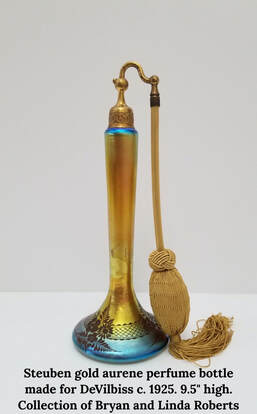|
Many of us have seen Tiffany lamps with distinctive glowing gold glass shades. The term for this type of glass is "aurene" and it became popular among high-end glass companies beginning in the early 20th century. Interestingly, it was Steuben Glass that first created aurene glass c. 1910 and today they remain the company most associated with it.
The term "aurene" was derived by combining the first three letters of the Latin word for gold (aurum) with the Middle English spelling of sheen (schene). The process of creating aurene glass was both complex and ingenious. When being fired, the glass was sprayed with stannous chloride, which coated the surface with microscopic ridges. The ridges reflected and refracted light striking the glass and in turn produced the lovely soft golden (or silver) glow of aurene. Depending on the salts used in the making of the glass, aurene could be gold, silver, or a bluish color. While Steuben pioneered aurene glass, other companies quickly adopted the process to their own lines, including Tiffany, Loetz, and Quezal. Today it remains popular with collectors and always brings a premium versus other, more common glass. Comments are closed.
|
AuthorBryan H. Roberts is a professional appraiser in Sarasota, FL. He is a member of the Florida State Guardianship Association and currently serves on the board of the local FSGA chapter. He is a past president of the Sarasota County Aging Network, a non-profit that provides grants to other non-profits benefiting seniors in need and is also a board member of PEL, an area non-profit whose resale store profits support programs and scholarships for at-risk and disadvantaged youth. He is certified in the latest Uniform Standards of Appraisal Practice (USPAP) Equivalent Archives
May 2024
Categories |


 RSS Feed
RSS Feed